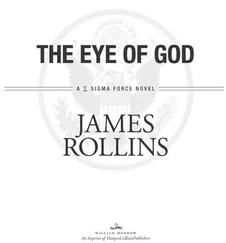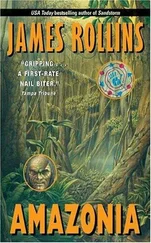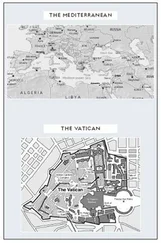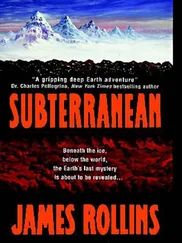“Hold tight, folks,” Jenny warned as they neared the far end of the tunnel.
“What are you—?”
Jenny shoved the wheel. The plane dipped. The floats struck the stream hard and skidded over its surface, casting a flume of water behind them. As the plane bounced back up, they were out of the tunnel and sailing high into the air.
Matt searched behind them as Jenny banked away.
From the tunnel mouth, the Cessna appeared, tumbling out, rolling end over end, wings broken. One of the propellers bounced free and spun up the snowy slope.
Matt turned back to his ex-wife with awe. The sudden backwash from her bounce against the stream had struck the other plane’s props and wings, causing the Cessna to bobble and brush against one of the tunnel walls.
A fatal mistake.
Jenny’s voice trembled. “I hate tailgaters.”
4:55 P.M.
ICE STATION GRENDEL
It was like stepping into a different world. The Crawl Space outside the Russian ice station was a natural warren of ice caverns and chutes. As Amanda passed over the threshold, she left not only the warmth of the station behind, but also all man-made structures.
Just outside the double doors to the base lay rusty piles of plate steel, bags of old concrete, stacks of conduit, and spools of wire. When it was first discovered, it was assumed the natural space in the ice was used as a storage annex, hence its nickname.
A structural engineer with the NASA group hypothesized that the station may have been constructed within a natural cavern inside the ice island, requiring less excavation. He suggested the Crawl Space might be the tiny remnant of the larger cavern system.
But outside such idle speculation, the Crawl Space held little fascination for most of Omega’s scientists. To them, it was just the janitor’s closet of the base. Only the geologists and glaciologists seemed truly fascinated by these back rooms and ice chutes.
“This way,” Dr. Ogden said, zipping his jacket up to his chin and pulling the fur-lined hood over his bald head. The biologist grabbed a flashlight from a stack near the door, flicked it on, and aimed past the cluttered entrance hall to the dark passages beyond. When he stood a moment longer, Amanda thought he might be speaking to her, but with his back turned, she couldn’t tell for sure. Before she could ask, he set off down toward the warren of tunnels.
Amanda followed. At least the geologists had spread sand on the ice floor for better footing. As she continued, leaving the lighted entrance behind, the air grew much colder. For some reason the motionless air seemed icier than on the surface. She lifted her warming mask from the belt of her thermal suit and flicked on the switch.
Henry Ogden continued, winding his way, passing side caverns, some empty, some stacked with gear. One alcove even contained butcher-wrapped packages and crates marked in Russian. Perishables, Amanda imagined. No need for freezers here.
As they continued deeper, she noted evidence of the scientists’ handiwork here: walls pocked with bore holes, some survey stakes with little flags, some pieces of modern equipment, even an empty Hostess Ding Dong box. She kicked this last aside as she passed. The new inhabitants of Ice Station Grendel were certainly leaving their unique footprints here.
Distracted by her surroundings, Amanda quickly became lost. Passages crisscrossed in all different directions. Dr. Ogden stopped at one of the intersections and searched the walls with his flashlight.
Amanda noted small spray-painted marks on the ice. They seemed freshly painted and varied in colors and shapes: red arrows, blue squiggles, and orange triangles. They were clearly signposts left behind by the scientists.
Henry touched a green dot, nodded to himself, and continued in that direction.
By now, the tunnels had narrowed and lowered overhead. Amanda had to hunch as she followed after the determined biologist. In the strangely still air, sparkles of ice crystals shone in the flashlight’s glow. Here the walls were so glassy that she spotted air bubbles trapped in the ice, glinting like pearls.
She ran gloved fingers along the wall. Silky smooth. Such tunnels and caves were formed as the surface ice melted in the summer’s heat, and the warm water leaked through cracks and fissures, flowing downward and melting out these shafts and pockets. Eventually the surface froze again, sealing and preserving the cavern system below.
Amanda gazed at the blue glass walls. There was a beauty here that warmed the cold. As she craned around, her heel slipped. Only a frantic grab for a spar halted her tumble.
Dr. Ogden glanced back to her. “Careful. It’s pretty slippery from here on.”
Now you tell me, she thought, and pulled herself back to her feet. She realized the spar she had grabbed was not ice. It was a chunk of rock protruding from the ice. She stared at it a moment as Dr. Ogden continued. It was one of the many inclusions, she realized, described by the geologists. She touched it with a bit of reverence. Here was a rock from whatever landmass this glacial chunk had broken away from eons ago.
Gloom settled around her as the biologist rounded a bend with his flashlight. Amanda hurried after him, regretting that she hadn’t collected one of the flashlights herself. She watched her footing now. Here the passages were not sanded. The geologists must not have ventured into this section of the Crawl Space yet.
Henry glanced back to her. “It’s just ahead.”
Amanda stared around her as the tunnel began to widen again. Within the glassy walls, boulders hung, an avalanche frozen in place. Deeper in the ice, other shadows darkened the upper reaches. They must be entering a cluster of inclusions.
Rounding a bend, the tunnel emptied into a large cave. Amanda lost her footing again and skated out of the tunnel. With her arms out for balance, she managed to stop herself.
She stood for a moment, stunned. The floor of the cavern was as large as an Olympic ice rink. But she quickly forgot the floor as she gaped at the chamber’s breadth and width. Arched over and around her was a huge natural cathedral: half ice and half stone .
She stood, surrounded by ice, but the back half of the chamber was solid rock. A bowl of stone encompassed the far wall and overhung the ceiling.
Something touched her elbow, startling her. It was only Dr. Ogden. He drew her eyes back to him, his lips moving.
“It’s the remnant of an ancient cliff face. At least according to MacFerran,” Henry said, naming the head of the geology team. “He says it must have broken from the landmass as the glacier calved and formed this ice island. It dates back to the last ice age. He immediately wanted to blast away sections and core out samples, but I had to stop him.”
Amanda was still too stunned to speak.
“On just cursory examination, I found dead lichen and frozen mosses. Searching the cliff pockets more thoroughly, I discovered three bird’s nests, one with eggs!” He began to speak more rapidly with his excitement. Amanda had to concentrate on his lips. “There were also a pack of rodents and a snake trapped in ice. It’s a treasure trove of life from that age, a whole frozen biosphere.” He led the way across the cavern toward the stone wall. “But that’s not all! Come see!”
She followed, staring ahead. The wall was not as solid as it had first appeared. It was pocked with cubbies and alcoves. Some sections seemed broken and half tumbled out. Deep clefts also delved into the rock face, but they were too dark to discern how far they penetrated.
Amanda crossed under the arch of stone and eyed with trepidation the slabs precariously balanced overhead. None of it seemed as solid as it had been a moment ago.
Читать дальше










